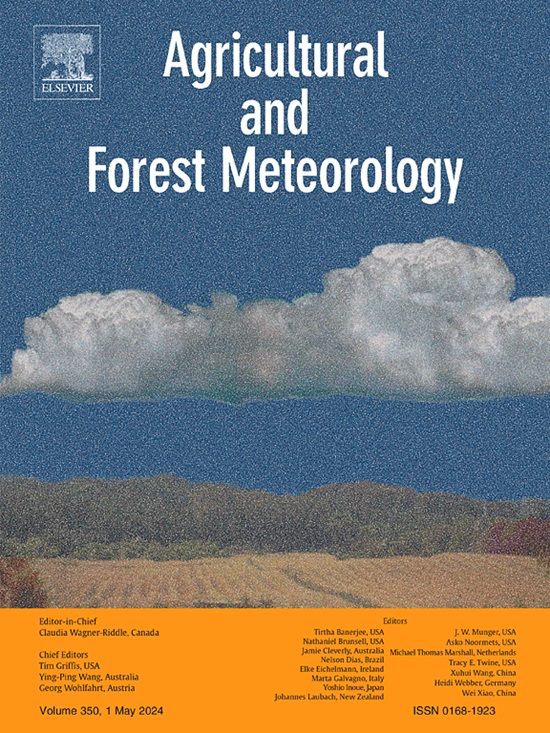基于高频涡动相关数据的蒸散分配水分利用效率模型评价——人工林立地间的比较
IF 5.7
1区 农林科学
Q1 AGRONOMY
引用次数: 0
摘要
水分利用效率(WUE)是影响通量方差相似性(FVS)蒸散发分离精度的关键参数,也是误差的主要来源。然而,关于FVS在多个人工林蒸散发分离中的应用的研究很少,从而限制了我们对人工林水分利用策略的理解。本研究利用从两个阔叶林和四个针叶林收集的涡动相关(EC)数据,评估了FVS框架下四个细胞间二氧化碳模型和一个优化模型(Opt)的结果。此外,我们还研究了水分利用效率与溶液速率的关系,以及蒸腾/蒸散比(T:ET)对土壤水分的响应。结果表明,除油松外,Sqrt模型与固定Ci值(Ci)和固定Ci/Ca比(K)模型的溶解率仅相差1% ~ 2%。此外,与Opt模型相比,Sqrt模型对T:ET的平均高估了8%。Ci、K和Sqrt模型的溶解率随WUE的增加而降低。在半小时尺度和日尺度上,人工林的溶液率分别为39% ~ 67%和29% ~ 76%。除线性模型外,其他模型均能有效地跟踪土壤水分的动态变化。本研究加深了我们对人工林5种水分利用效率模型间FVS分离的差异性和一致性的认识,为人工林水分利用效率模型的选择提供了依据。本文章由计算机程序翻译,如有差异,请以英文原文为准。
Evaluation of water use efficiency model in evapotranspiration partitioning from high-frequency eddy covariance data - a comparison between plantation sites
Water use efficiency (WUE) represents a crucial parameter and a major source of error influencing the accuracy of evapotranspiration separation through flux variance similarity (FVS). However, there is a paucity of studies investigating the application of FVS for the separation of evapotranspiration across multiple plantations, thereby constraining our understanding of water use strategies in plantation forests. This study assessed the outcomes of four intercellular carbon dioxide models and an optimization model (Opt) within the FVS framework, utilizing Eddy Covariance (EC) data gathered from two broad-leaf plantations and four coniferous plantations. Additionally, we examined the relationship between WUE and solution rate, as well as the responsiveness of the proportion of transpiration to evapotranspiration (T:ET) to soil moisture. The results showed that the solution rate of the Sqrt model differed by only 1 % - 2 % from the constant Ci value (Ci) and the constant Ci/Ca ratio (K) model in plantations, excluding Pinus tabuliformis. Moreover, the Sqrt model exhibited an average overestimation of T:ET by 8 % compared to the Opt model. The solution rate of Ci, K, and Sqrt models were decreased with an increase in WUE. At a half-hour scale and daily scale, the plantation's solution rate was ranged from 39 % to 67 %, and 29 % to 76 %, respectively. Except for the Linear model, all other models effectively tracked the dynamic changes in soil moisture. This study enhanced our understanding about the distinctions and consistencies in FVS separation among five WUE models in plantations, providing a foundation for the selection of WUE models to elucidate water use strategies in plantations.
求助全文
通过发布文献求助,成功后即可免费获取论文全文。
去求助
来源期刊
CiteScore
10.30
自引率
9.70%
发文量
415
审稿时长
69 days
期刊介绍:
Agricultural and Forest Meteorology is an international journal for the publication of original articles and reviews on the inter-relationship between meteorology, agriculture, forestry, and natural ecosystems. Emphasis is on basic and applied scientific research relevant to practical problems in the field of plant and soil sciences, ecology and biogeochemistry as affected by weather as well as climate variability and change. Theoretical models should be tested against experimental data. Articles must appeal to an international audience. Special issues devoted to single topics are also published.
Typical topics include canopy micrometeorology (e.g. canopy radiation transfer, turbulence near the ground, evapotranspiration, energy balance, fluxes of trace gases), micrometeorological instrumentation (e.g., sensors for trace gases, flux measurement instruments, radiation measurement techniques), aerobiology (e.g. the dispersion of pollen, spores, insects and pesticides), biometeorology (e.g. the effect of weather and climate on plant distribution, crop yield, water-use efficiency, and plant phenology), forest-fire/weather interactions, and feedbacks from vegetation to weather and the climate system.

 求助内容:
求助内容: 应助结果提醒方式:
应助结果提醒方式:


